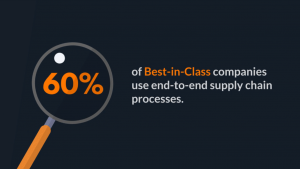The days of preparing for new trade policies are over. For decades, companies were given advance notice of coming tariff announcements, with time to adapt to the upcoming changes. But that has changed in today’s “tweet today, implement tomorrow” pace of business. That speed and volatility have opened the door for a new style of global trade management to emerge.
Defining the new era of best practices for tariff and trade management
A recent Aberdeen Group survey of 126 companies identified the organizations that excel at global trade management and the key factors that drive their success. These Best-in-Class companies, as Aberdeen labels them, have kept trade compliance costs low while still achieving a high percentage of perfect deliveries to and from international suppliers. Aberdeen finds that these companies aren’t exclusively relying on specialized global trade management software and processes to become Best-in-Class. The group has identified a few foundational tactics that other companies can implement on their journey to become Best-in-Class organizations.
The first step to better tariff management: end-to-end planning
Aberdeen Group calls end-to-end planning “the first major step” towards establishing better tariff and trade management practices. End-to-end planning processes connect functions across the supply chain, increase visibility into the network and improve response times. Most companies adopt end-to-end planning to enhance daily supply chain operations, break down silos and improve decision-making, but the impact of these capabilities is magnified in times of volatility. Consider Lippert Components. Trade was not top of mind for the company when it switched to an end-to-end planning system. Instead, its goal was to improve demand planning processes. Planners had better collaboration across business functions and greater access to data with end-to-end visibility across the network. Their demand forecasts became more accurate, which improved day-to-day outcomes for the business, but an added benefit of this transformation was that it helped Lippert Components manage unexpected changes to its supply chain.
Source: Preparing Your Supply Chain for Global Trade: Lessons from the Best-in-Class Companies, Bryan Bell, Aberdeen 2019.[/caption] When new time-phased tariffs were announced in 2018, Lippert’s planners were asked to estimate the costs to the business. Using end-to-end planning processes, they were able to quickly create a workbook that projected the tariffs' impacts. Planners estimate that it would have taken weeks to gather data and conduct analysis using their previous planning system. In 2018, it only took minutes to generate a report. This meant that the short time between the tariffs’ announcement and implementation was wholly devoted to strategizing and implementing cost-saving measures.
60 percent of Best-in-Class companies are using end-to-end planning processes
Sixty percent of Best-in-Class companies are using end-to-end planning processes for decision-making, compared to only 34 percent of all other companies. This is despite the fact that such process are foundational not only for global trade management but also for other supply chain best practices. Aberdeen Group says end-to-end planning is not the only key competency holding supply chains back. Many still rely on manual processes (28% of all companies), fail to invest in technology that would improve productivity (only 25% of Best-in-Class and 10% of all others have invested) and lack the ability to classify SKUs (69% of Best-in-Class have this capability but only 29% of all others do). “To succeed moving forward, companies must evaluate and address the lingering shortcomings (in terms of information silos, poor communications and outdated technologies) from past practices,” writes Aberdeen Group. Although these capabilities have been around for years, many supply chains – even among Best-in-Class companies – still have improvements to make. In the current era of trade volatility, these are skills companies can’t afford to overlook. Download the full report to learn more: Preparing Your Supply Chain for Global Trade: Lessons from the Best-in-Class Companies, Bryan Ball, Aberdeen 2019.






Leave a Reply